Human-Dog Relationship during the First COVID-19 Lockdown in Italy
Abstract
:Simple Summary
Abstract
1. Introduction
2. Materials and Methods
2.1. General and Demographic Information on Dog Owners and Their Dogs
2.2. Measures
2.3. Information on Dog’s Lifestyle during the Quarantine
2.4. Information on Clinical and Behavioral Symptoms in the Dogs during the Quarantine
2.5. Owner Perception of Distress and Emotional Discomfort in the Dogs during the Quarantine
2.6. Data Analysis
2.6.1. Statistical Analysis
2.6.2. Internal Consistency
2.6.3. Construct Validity
2.6.4. Differences between the Means
3. Results
3.1. General and Demographic Information on Dog Owners
3.2. General Information of the Dogs
3.3. Monash Scale
3.3.1. Internal Reliability
3.3.2. Construct Validity
3.3.3. Perceived Difference between before and during the Quarantine
3.4. Information on Dog’s Lifestyle during the Quarantine
3.5. Information on Clinical and Behavioral Symptoms in the Dog during the Quarantine
3.6. Owner Perception of Distress and Emotional Discomfort in the Dogs during the Quarantine
4. Discussion
- (1)
- Fear that the reading of the dog’s discomfort may be compromised by a state of psychological discomfort of the owner and that this discomfort may affect an objective reading of the dog’s discomfort. In fact, it has been shown that stress and poor welfare of owners negatively affect the well-being of their pets [35].
- (2)
- To allow owners to report the increased or decreased frequency of symptoms during the whole lockdown compared to the previous period. In fact, we believe that having a survey carried out in the first weeks of the lockdown could have given unreliable answers. In fact, a modified intensity of the symptoms could be attributable to the temporary adaptation phase of the dog due to the change of routine that the lockdown imposed [20].
- (3)
- In order to obtain complete feedback from the owner regarding the entire period of maximum restriction in relation to the Monash scale: interaction vs. perceived costs.
4.1. Dog Owners
4.2. Dogs
4.3. Dog’s Lifestyle during Quarantine
4.4. Behavioral Symptoms
4.5. Owner Perception of Distress and Emotional Discomfort in the Dogs during the Quarantine
5. Conclusions
6. Limitations
Author Contributions
Funding
Institutional Review Board Statement
Data Availability Statement
Acknowledgments
Conflicts of Interest
References
- Costagliola, A.; Liguori, G.; d’Angelo, D.; Costa, C.; Ciani, F.; Giordano, A. Do Animals Play a Role in the Transmission of Severe Acute Respiratory Syndrome Coronavirus-2 (SARS-CoV-2)? A Commentary. Animals 2020, 11, 16. [Google Scholar] [CrossRef]
- Cochrane Library. Available online: https://www.cochranelibrary.com/collections/doi/SC000040/full (accessed on 16 April 2021).
- Chirico, A.; Lucidi, F.; Galli, F.; Giancamilli, F.; Vitale, J.; Borghi, S.; La Torre, A.; Codella, R. COVID-19 Outbreak and Physical Activity in the Italian Population: A Cross-Sectional Analysis of the Underlying Psychosocial Mechanisms. Front. Psychol. 2020, 11, 2100. [Google Scholar] [CrossRef]
- Torales, J.; O’Higgins, M.; Castaldelli-Maia, J.M.; Ventriglio, A. The outbreak of COVID-19 coronavirus and its impact on global mental health. Int. J. Soc. Psychiatry 2020, 66, 317–320. [Google Scholar] [CrossRef] [Green Version]
- Gerst-Emerson, K.; Jayawardhana, J. Loneliness as a public health issue: The impact of loneliness on health care utilization among older adults. Am. J. Public Health. 2015, 105, 1013–1019. [Google Scholar] [CrossRef] [PubMed]
- Holt-Lunstad, J.; Smith, T.B.; Layton, J.B. Social relationships and mortality risk: A meta-analytic review. PLoS Med. 2010, 7, e1000316. [Google Scholar] [CrossRef] [PubMed]
- Ratschen, E.; Shoesmith, E.; Shahab, L.; Silva, K.; Kale, D.; Toner, P.; Reeve, C.; Mills, D.S. Human-animal relationships and interactions during the Covid-19 lockdown phase in the UK: Investigating links with mental health and loneliness. PLoS ONE 2020, 15, e0239397. [Google Scholar] [CrossRef]
- Allen, K.; Blascovich, J.; Mendes, W.B. Cardiovascular reactivity and the presence of pets, friends, and spouses: The truth about cats and dogs. Psychosom. Med. 2002, 64, 727–739. [Google Scholar]
- Polheber, J.P.; Matchock, R.L. The presence of a dog attenuates cortisol and heart rate in the Trier Social Stress Test compared to human friends. J. Behav. Med. 2014, 37, 860–867. [Google Scholar] [CrossRef]
- Carr, E.C.J.; Wallace, J.E.; Pater, R.; Gross, D.P. Evaluating the Relationship between Well-Being and Living with a Dog for People with Chronic Low Back Pain: A Feasibility Study. Int. J. Environ. Res. Public Health 2019, 16, 1472. [Google Scholar] [CrossRef] [PubMed] [Green Version]
- Meyer, I.; Forkman, B. Dog and owner characteristics affecting the dog-owner relationship. J. Vet. Behav. 2014, 9, 143–150. [Google Scholar] [CrossRef] [Green Version]
- d’Angelo, D.; d’Ingeo, S.; Ciani, F.; Visone, M.; Sacchettino, L.; Avallone, L.; Quaranta, A. Cortisol Levels of Shelter Dogs in Animal Assisted Interventions in a Prison: An Exploratory Study. Animals 2021, 11, 345. [Google Scholar] [CrossRef]
- Müller, C.A.; Schmitt, K.; Barber, A.L.; Huber, L. Dogs can discriminate emotional expressions of human faces. Curr. Biol. 2015, 25, 601–605. [Google Scholar] [CrossRef] [PubMed] [Green Version]
- Nagasawa, M.K.M.; Kikusui, T. Attachment between humans and dogs. Jpn. Psychol. Res. 2009, 51, 209–221. [Google Scholar] [CrossRef]
- Albuquerque, N.; Guo, K.; Wilkinson, A.; Savalli, C.; Otta, E.; Mills, D. Dogs recognize dog and human emotions. Biol. Lett. 2016, 12, 20150883. [Google Scholar] [CrossRef] [PubMed] [Green Version]
- Ministero Della Salute, Italia. Available online: http://www.salute.gov.it/portale/news/p3_2_1_1_1.jsp?lingua=italiano&menu=notizie&p=dalministero&id=4186 (accessed on 20 May 2021).
- Netting, F.E.; Wilson, C.C.; New, J.C. The Human-Animal Bond: Implications for Practice. Soc. Work 1987, 32, 60–64. [Google Scholar] [CrossRef]
- Dwyer, F.; Bennett, P.C.; Coleman, G. Development of the Monash Dog Owner Relationship Scale (MDORS). Anthrozoos 2006, 19, 243–256. [Google Scholar] [CrossRef]
- Hambleton, R.K.; Patsula, L. Adapting Tests for Use in Multiple Languages and Cultures. Soc. Indic. Res. 1998, 45, 153–171. [Google Scholar] [CrossRef]
- Salonen, M.; Sulkama, S.; Mikkola, S.; Puurunen, J.; Hakanen, E.; Tiira, K.; Araujo, C.; Lohi, H. Prevalence, comorbidity, and breed differences in canine anxiety in 13,700 Finnish pet dogs. Sci. Rep. 2020, 10, 2962. [Google Scholar] [CrossRef] [PubMed] [Green Version]
- RStudio Team. RStudio: Integrated Development for R; RStudio: Boston, MA, USA, 2017. [Google Scholar]
- Revelle, W.R. psych: Procedures for Personality and Psychological Research; Northwest University Evanston: Illinois, IL, USA, 2019. [Google Scholar]
- Bernaards, C.A.; Jennrich, R.I. Gradient Projection Algorithms and Software for Arbitrary Rotation Criteria in Factor Analysis. Educ. Psychol. Meas. 2005, 65, 676–696. [Google Scholar] [CrossRef]
- Korkmaz, S.; Goksuluk, D.; Zararsiz, G. MVN: An R Package for Assessing Multivariate Normality. R J. 2014, 6, 151. [Google Scholar] [CrossRef] [Green Version]
- Tavakol, M.; Dennick, R. Making sense of Cronbach’s alpha. Int. J. Med. Educ. 2011, 2, 53–55. [Google Scholar] [CrossRef]
- Costello, A.B.; Osborne, J.W. Four Recommendations for Getting the Most from Your Analysis. Pract. Assess Res. Eval. 2005, 10, 7. [Google Scholar]
- Velicer, W.F.; Jackson, D.N. Component Analysis versus Common Factor Analysis: Some Issues in Selecting an Appropriate Procedure. Multivar. Behav. Res. 1990, 25, 1–28. [Google Scholar] [CrossRef] [PubMed]
- Horn, J.L. A rationale and test for the number of factors in factor analysis. Psychometrika 1965, 30, 179–185. [Google Scholar] [CrossRef]
- Ledesma, R.D.; Valero-Mora, P. Determining the Number of Factors to Retain in EFA: An easy-to-use computer program for carrying out Parallel Analysis. Pract. Assess. Res. Eval. 2007, 12, 2. [Google Scholar]
- Williams, B.; Onsman, A.; Brown, T. Exploratory factor analysis: A five-step guide for novices. J. Emerg. Prim. Health Care 2010, 8, 1–13. [Google Scholar] [CrossRef] [Green Version]
- Hu, L.; Bentler, P.M. Cutoff criteria for fit indexes in covariance structure analysis: Conventional criteria versus new alternatives. Struct. Equ. Model. Multidiscip. J. 1999, 6, 1–55. [Google Scholar] [CrossRef]
- Nunnally, J.; Bernstein, I. Psychometric Theory, 3rd ed.; McGraw-Hill: New York, NY, USA, 1994. [Google Scholar]
- Survey Online. Available online: https://survey.zohopublic.eu/zs/irB8nY (accessed on 20 May 2021).
- Field, A.; Miles, J.; Field, Z. Discovering Statistics Using R; SAGE Publications: London, UK, 2014. [Google Scholar]
- Morgan, L.; Protopopova, A.; Birkler, R.I.D.; Itin-Shwartzd, B.; Suttona, G.A.; Gamliela, A.; Yakobsone, B.; Raza, T. Human-dog relationships during the COVID-19 pandemic: Booming dog adoption during social isolation. Humanit. Soc. Sci. Commun. 2020, 7, 155. [Google Scholar] [CrossRef]
- Bowen, J.; García, E.; Darder, P.; Argüelles, J.; Fatjó, J. The effects of the Spanish COVID-19 lockdown on people, their pets, and the human-animal bond. J. Vet. Behav. 2020, 40, 75–91. [Google Scholar] [CrossRef] [PubMed]
- Holland, K.E.; Owczarczak-Garstecka, S.C.; Anderson, K.L.; Casey, R.A.; Christley, R.M.; Harris, L.; McMillan, K.M.; Mead, R.; Murray, J.K.; Samet, L.; et al. “More Attention than Usual”: A Thematic Analysis of Dog Ownership Experiences in the UK during the First COVID-19 Lockdown. Animals 2021, 11, 240. [Google Scholar] [CrossRef] [PubMed]
- Shaw, J.; Bonnett, B.; Roter, D.; Adams, C.; Larson, S. Gender differences in veterinarian-client-patient communication in companion animal practice. J. Am. Vet. Med. Assoc. 2012, 241, 81–88. [Google Scholar] [CrossRef]
- Smith, W.G. Does Gender Influence Online Survey Participation?: A Record-Linkage Analysis of university Faculty Online Survey Response Behavior; San Jose State University: San Jose, CA, USA, 2008. [Google Scholar]
- Christley, R.M.; Murray, J.K.; Anderson, K.L.; Buckland, E.L.; Casey, R.A.; Harvey, N.D.; Harris, L.; Holland, K.E.; McMillan, K.M.; Mead, R.; et al. Impact of the First COVID-19 Lockdown on Management of Pet Dogs in the UK. Animals 2021, 11, 5. [Google Scholar] [CrossRef]
- Bloom, T.; Friedman, H. Classifying dogs’ (Canis familiaris) facial expressions from photographs. Behav. Process. 2013, 96, 1–10. [Google Scholar] [CrossRef]
- Reisner, I.R.; Shofer, F.S. Effects of gender and parental status on knowledge and attitudes of dog owners regarding dog aggression toward children. J. Am. Vet. Med. Assoc. 2008, 233, 1412–1419. [Google Scholar] [CrossRef]
- Meints, K.; Racca, A.; Hickey, N. How to prevent dog bite injuries? Children misinterpret dogs’ facial expressions. Inj. Prev. 2010, 16, 1136. [Google Scholar] [CrossRef] [Green Version]
- Lakestani, N.N.; Donaldson, M.L.; Waran, N. Interpretation of dog behavior by children and young adults. Anthrozoös 2014, 27, 65–80. [Google Scholar] [CrossRef]
- Tami, G.; Gallagher, A. Description of the behaviour of domestic dog (Canis familiaris) by experienced and inexperienced people. Appl. Anim. Behav. Sci. 2009, 120, 159–169. [Google Scholar] [CrossRef]
- Wan, M.; Bolger, N.; Champagne, F.A. Human perception of fear in dogs varies according to experience with dogs. PLoS ONE 2012, 7, e51775. [Google Scholar] [CrossRef] [PubMed]
- Clauss-Ehlers, S.C. Sociocultural factors, resilience, and coping: Support for a culturally sensitive measure of resilience. J. Appl. Dev. Psychol. 2008, 29, 197–212. [Google Scholar] [CrossRef]
- Fleming, C.M.; Bowden, M. Web-based surveys as an alternative to traditional mail methods. J. Env. Manag. 2009, 90, 284–292. [Google Scholar] [CrossRef] [PubMed] [Green Version]
- Jezierski, T.; Camerlink, I.; Peden, R.S.E.; Chou, J.Y.; Marchewka, J. Changes in the health and behaviour of pet dogs during the COVID-19 pandemic as reported by the owners. Appl. Anim. Behav. Sci. 2021, 241, 105395. [Google Scholar] [CrossRef]
- Merola, I.; Prato-Previde, E.; Marshall-Pescini, S. Social referencing in dog-owner dyads? Anim. Cogn. 2012, 15, 175–185. [Google Scholar] [CrossRef] [PubMed]
- d’Angelo, D.; Ciani, F.; Zaccherini, A.; Tafuri, S.; Avallone, L.; d’Ingeo, S.; Quaranta, A. Human-Animal Relationship Dys-function: A Case Study of Animal Hoarding in Italy. Animals 2020, 10, 1501. [Google Scholar] [CrossRef]
- Merola, I.; Prato-Previde, E.; Lazzaroni, M.; Marshall-Pescini, S. Dogs’ comprehension of referential emotional expressions: Familiar people and familiar emotions are easier. Anim. Cogn. 2014, 17, 373–385. [Google Scholar] [CrossRef]
- Palmer, R.; Custance, D. A counterbalanced version of Ainsworth’s Strange Situation Procedure reveals secure-base effects in dog—Human relationships. Appl. Anim. Behav. Sci. 2008, 109, 306–319. [Google Scholar] [CrossRef]
- Miklosi, A. Social Cognition. In Dog Behaviour, Evolution, and Cognition; Publisher Oxford Scolarship Online: Oxford, UK, 2008. [Google Scholar] [CrossRef]
- Duranton, C.; Bedossa, T.; Gaunet, F. Interspecifc behavioral synchronization: Dogs exhibit locomotor synchrony with humans. Sci. Rep. 2017, 7, 1–9. [Google Scholar] [CrossRef] [PubMed] [Green Version]
- Duranton, C.; Gaunet, F. Behavioral synchronization and affiliation: Dogs exhibit human like skills. Learn. Behav. 2018, 46, 364–373. [Google Scholar] [CrossRef] [PubMed] [Green Version]
- Wanser, S.H.; MacDonald, M.; Udell, M. Dog—Human behavioral synchronization: Family dogs synchronize their behavior with child family members. Anim. Cogn. 2021, 24, 747–752. [Google Scholar] [CrossRef]
- Pawling, R.; Cannon, P.R.; McGlone, F.P.; Walker, S.C. C-tactile afferent stimulating touch carries a positive affective value. PLoS ONE 2017, 12, e0173457. [Google Scholar] [CrossRef] [PubMed] [Green Version]
- Sommerville, R.; O’Connor, E.A.; Asher, L. Why do dogs play? Function and welfare implications of play in the domestic dog. Appl. Anim. Behav. Sci. 2017, 197, 1–8. [Google Scholar] [CrossRef]
- Wells, D.L. A review of environmental enrichment for kennelled dogs, Canis familiaris. Appl. Anim. Behav. Sci. 2004, 85, 307–317. [Google Scholar] [CrossRef]
- Dixon, C.A.; Mistry, R.D. Dog Bites in Children Surge during Coronavirus Disease-2019: A Case for Enhanced Prevention. J Pediatr. 2020, 225, 231–232. [Google Scholar] [CrossRef]
- Palagi, E.; Guillén-Salazar, F.; Llamazares-Martín, C. Spontaneous Yawning and its Potential Functions in South American Sea Lions. Sci. Rep. 2019, 9, 17226. [Google Scholar] [CrossRef] [Green Version]
- Hatfield, E.; Cacioppo, J.T.; Rapson, R.L. Emotional contagion. Curr. Dir. Psychol. Sci. 1993, 2, 96–100. [Google Scholar] [CrossRef]
- Koolhaas, J.M.; Bartolomucci, A.; Buwalda, B.; de Boer, S.F.; Flügge, G.; Korte, S.M.; Meerlo, P.; Murison, R.; Olivier, B.; Palanza, P.; et al. Stress revisited: A critical evaluation of the stress concept. Neurosci. Biobehav. Rev. 2011, 35, 1291–1301. [Google Scholar] [CrossRef]
- Esam, F.; Forrest, R.; Waran, N. Locking down the Impact of New Zealand’s COVID 19 Alert Level Changes on Pets. Animals 2021, 11, 758. [Google Scholar] [CrossRef] [PubMed]
- Jordan, T.; Lem, M. One Health, One Welfare: Education in practice veterinary students’ experiences with Community Veterinary Outreach. Can. Vet. J. 2014, 55, 1203–1206. [Google Scholar] [PubMed]
- Das, J.; Hammer, J.; Sánchez-Paramo, C. The impact of recall periods on reported morbidity and health seeking behavior. J. Dev. Econ. 2012, 98, 76–88. [Google Scholar] [CrossRef] [Green Version]
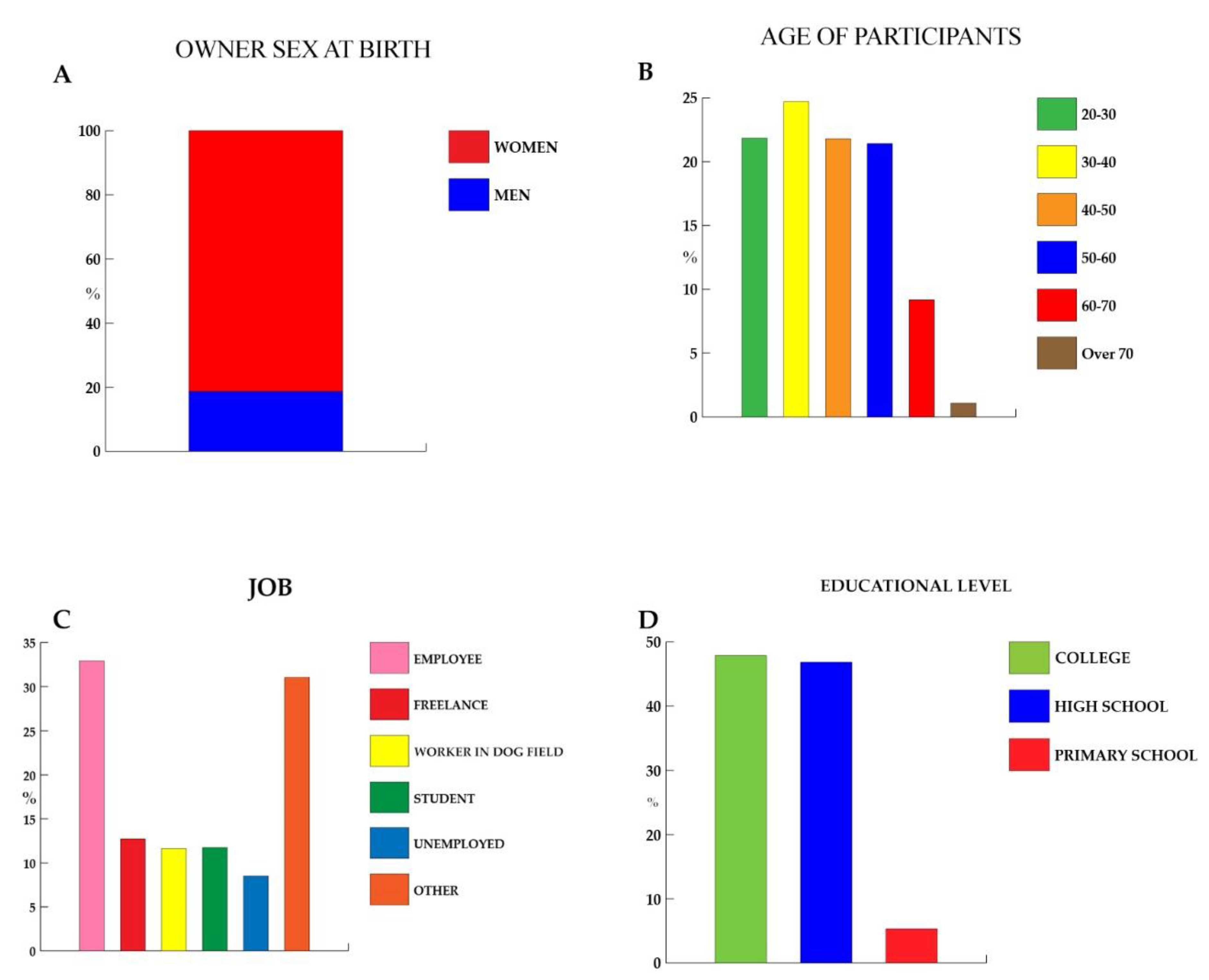
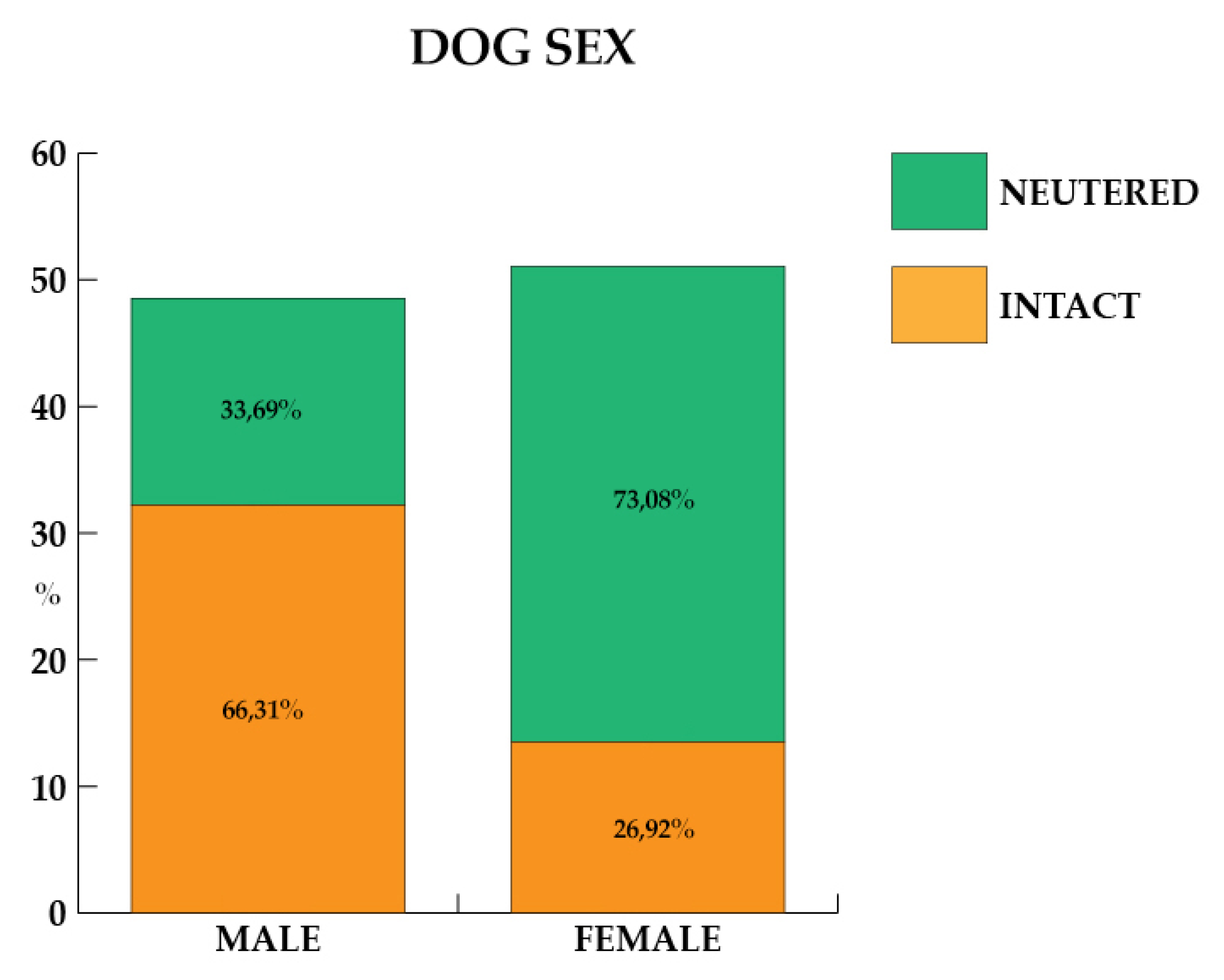

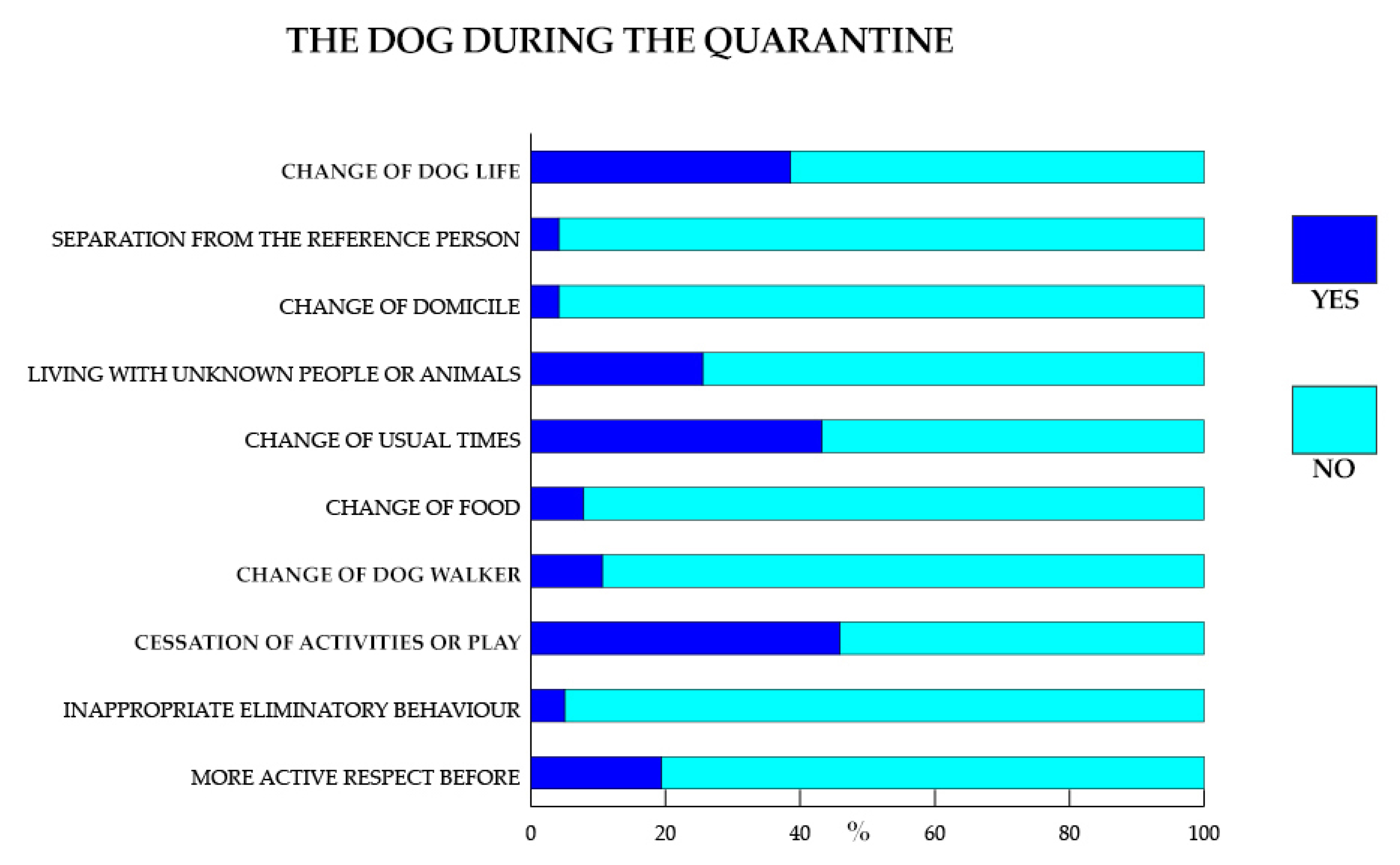
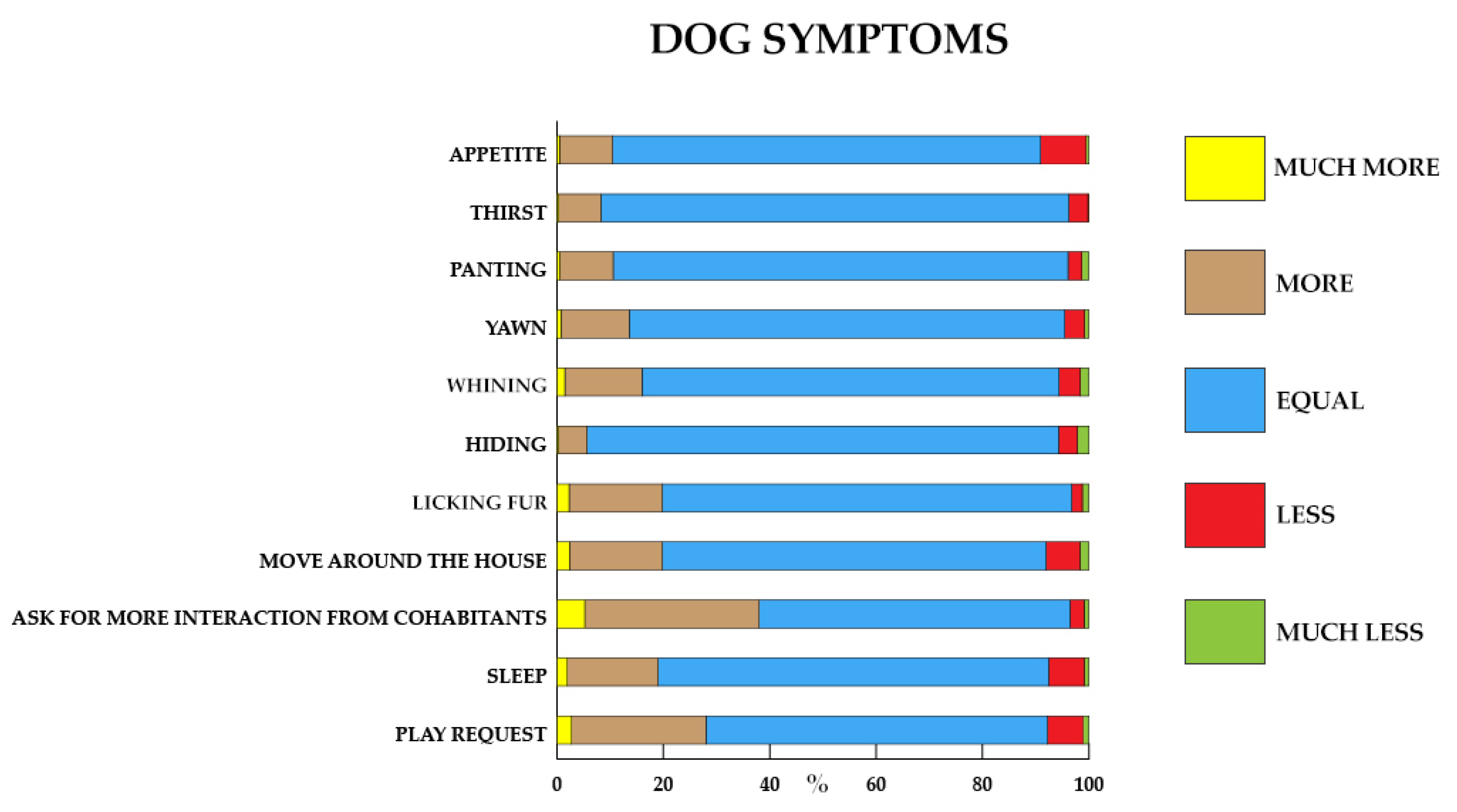
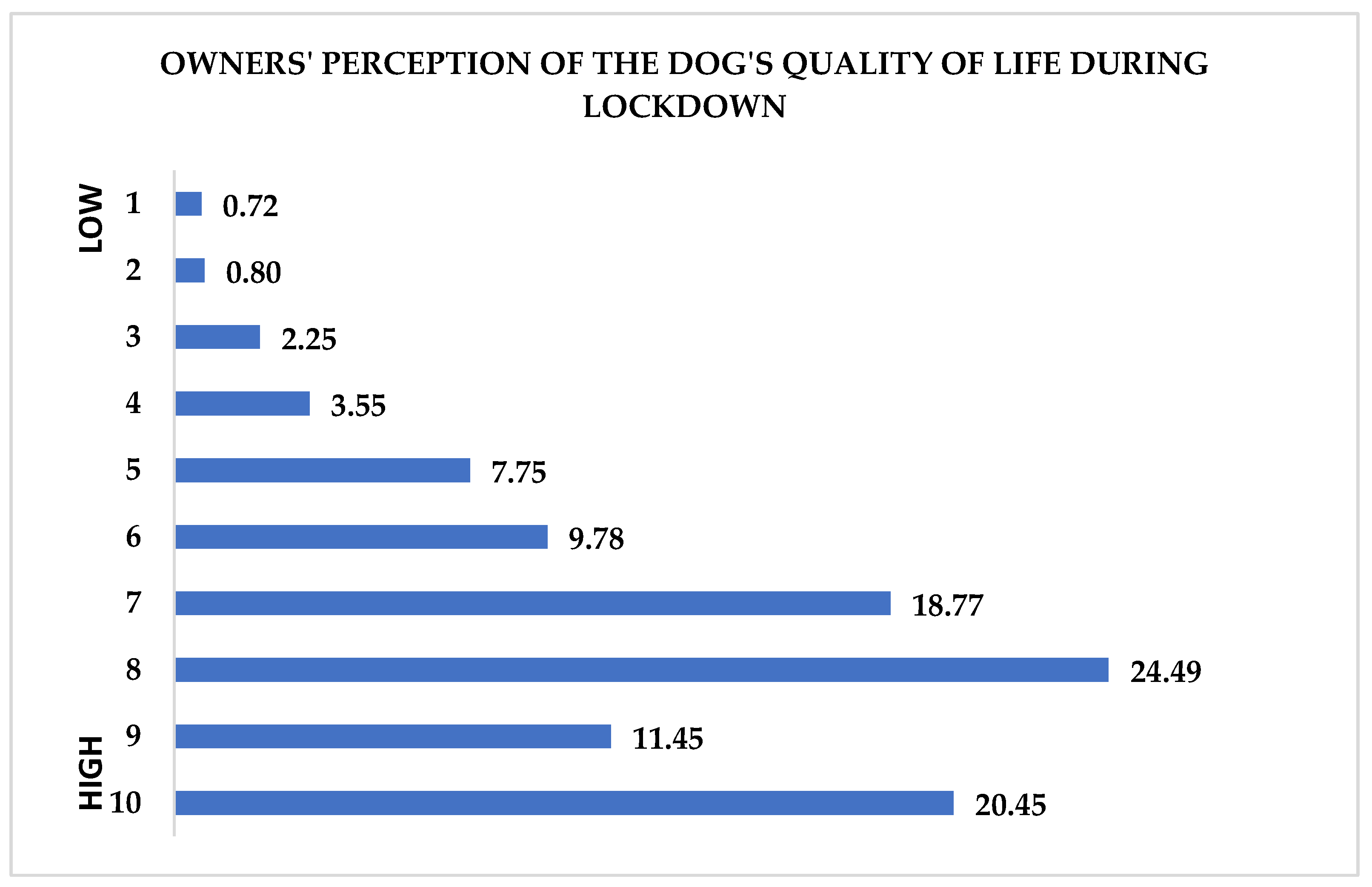
| Items | F1 | F2 |
|---|---|---|
| How often do you hug your dog? (Quanto spesso abbracci il tuo cane?) | 0.871 | |
| How often do you kiss your dog? (Quanto spesso baci il tuo cane?) | 0.748 | |
| How often do you play with your dog? (Quanto spesso giochi con il tuo cane?) | 0.340 | |
| It bothers me that my dog stops me doing things I enjoyed doing before I owned it. (Mi infastidisce che il mio cane non mi fa svolgere alcune attività che mi piaceva fare prima di possederlo) | 0.709 | |
| It is annoying that I sometimes have to change my plans because of my dog. (E’ scocciante dover cambiare i miei piani a causa del mio cane) | 0.707 | |
| There are major aspects of owning a dog I don’t like. (Ci sono degli aspetti rilevanti del possedere un cane che non mi piacciono) | 0.745 | |
| How often do you feel that looking after your dog is a chore? (Quanto spesso senti che prendersi cura del tuo cane è un impegno?) | 0.476 | |
| My dog costs too much money. (La gestione del mio cane costa troppo) | 0.381 | |
| How often does your dog stop you doing things you want to? (Quanto spesso il tuo cane ha interrotto o impedito le attività che avresti voluto fare?) | 0.301 |
Publisher’s Note: MDPI stays neutral with regard to jurisdictional claims in published maps and institutional affiliations. |
© 2021 by the authors. Licensee MDPI, Basel, Switzerland. This article is an open access article distributed under the terms and conditions of the Creative Commons Attribution (CC BY) license (https://creativecommons.org/licenses/by/4.0/).
Share and Cite
d’Angelo, D.; Chirico, A.; Sacchettino, L.; Manunta, F.; Martucci, M.; Cestaro, A.; Avallone, L.; Giordano, A.; Ciani, F. Human-Dog Relationship during the First COVID-19 Lockdown in Italy. Animals 2021, 11, 2335. https://doi.org/10.3390/ani11082335
d’Angelo D, Chirico A, Sacchettino L, Manunta F, Martucci M, Cestaro A, Avallone L, Giordano A, Ciani F. Human-Dog Relationship during the First COVID-19 Lockdown in Italy. Animals. 2021; 11(8):2335. https://doi.org/10.3390/ani11082335
Chicago/Turabian Styled’Angelo, Danila, Andrea Chirico, Luigi Sacchettino, Federica Manunta, Maurizio Martucci, Anna Cestaro, Luigi Avallone, Antonio Giordano, and Francesca Ciani. 2021. "Human-Dog Relationship during the First COVID-19 Lockdown in Italy" Animals 11, no. 8: 2335. https://doi.org/10.3390/ani11082335
APA Styled’Angelo, D., Chirico, A., Sacchettino, L., Manunta, F., Martucci, M., Cestaro, A., Avallone, L., Giordano, A., & Ciani, F. (2021). Human-Dog Relationship during the First COVID-19 Lockdown in Italy. Animals, 11(8), 2335. https://doi.org/10.3390/ani11082335









